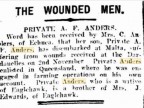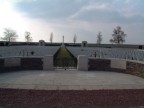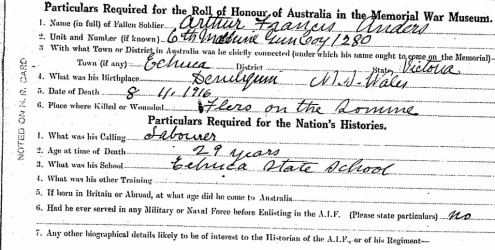ANDERS Arthur Francis
-

- 1280
- Private
- 23 Battalion
- 26th Battalion
- Teutoberg
- Yes
- 1887
- Deniliquin - NSW - Australia
- 18 May 1915
- HMAT A11 Ascanius
- 10 May1915
- Brisbane
-
Francis Arthur ANDERS 1280 was born in 1887 in Deniliquin, NSW. Son of Charles Herman and Ellen (nee Baldwin) Anders, of Francis Street, Echuca, Victoria. He had six brothers and two sisters. He attended the Echuca State School in Victoria.
The Queensland Electoral Roll of 1913-15 shows him as a Selector, living at Teutoberg (Witta).
His Attestation paper describes him as a coach driver, single aged 28 years. He gave his mother as his next of kin.
Francis enlisted on 18 May 1915 in Queensland with the 26th Battalion raised at Enoggera in Brisbane.
He embarked from Brisbane on board HMAT A11 Ascanius on 24 May 1915. He was considered fit for service “at sea” on 23 June 1915.
On 19 August 1915 he Transferred from 26 Battalion to 23 Battalion.
Arrived at Gallipoli in September 1915.
On 27 October 1915 Francis was admitted to the 6th field ambulance wounded.
On 2 November 1915 admitted to the Military Hospital at Tigne with a gunshot wound to the right leg at Gallipoli and was treated and hospitalised in Malta. He left Malta for Egypt per hospital ship Lanfrano and admitted to the 1st Auxilliary hospital, Cairo on 5 February 1916.
In April he was declared medically unfit and as a result was to be returned home. A second review declared him fit for duty and he was sent to France. On 1 April 1916, he was admitted to No. 3 Auxiliary Hospital, Cairo following a GSW to his eye He returned to duty 16 April and when he got to Zeitoun his knee was swollen again – Paraded next morning and on being inspected by the medical officer was put off duty because his knee was swollen. He was then sent to No. 2 Stationery Hospital.
On 30 May he proceeded to join BEF at Alexandria. Disembarked Marseilles on 5 June 1916.
On 31 July 1916 he was admitted to the 20 General Hospital, Camiers, suffering from influenza. Discharged to duty 4 August.
On 15 September 1916 he joined the 6th Machine Gun Company (reinforcements) as a supernumery joining his brother Alf where they fought side by side in the trenches.
A POZIERES EXPERIENCE.
The following letter has been received by Nurse Bagnoll, of Benalla, from Private Alf. Anders, formerly employed by Mr. R. J. Cooke, who went right through the Gallipoli campaign, and is now serving with the Anzacs in France. Writing under date 23/8/16, he says: — 'The last letter I received from you is buried somewhere near Pozieres cemetery with my haversack and other things. I did not wait to look for them when I got out of the wreckage. Myself and other gunners were in a small dugout, when a 5.9 inch high explosive shell hit the roof and away it went. A dull thud, a bright red flash, blue stars, smoke and dust, and broken timber hitting our steel hats, was the sensation we got. It seems marvelous that not one of as was hit at all, for if the shell had hit the end or gone through the roof without bursting, we would have been blown to atoms. Outside the guns were going at a terrific pace, but our side was getting in five shells to Fritz's one. After a scramble out of the wreckage of our dugout, we lay down in a shallow trench for 8 hours, and the place was as bright as day. There was a regular curtain fire right through the cemetery and wood just a few yards ahead. The range was shortened, and now the fire was behind us. We dare not move away to better shelter, as we had our guns ready expecting the Germans to come at us at dawn, but they did not show up. Our side got in their final say with the artillery. Friz must have had a terrible time with the bombardment, as it had been kept on him for weeks. There were more shells fired on the night above referred to than all the time on Gallipoli, A few days later we went at Fritz again and gave him a great doing, taking two lines of trenches. They will not fight at close quarters. The ones we captured were a fine big lot of fellows, well dressed and fed, but seemed pleased to be taken prisoners. The day after the attack a large party was found out in a strong post, and the trench mortars were turned on it. As soon as a couple of bombs dropped inside, out came the Huns like rabbits, and what sport some of the gunners and snipers had. They bowled over about fifty and took the post, getting a lot of kit and three machine guns. The whole country is absolutely torn up. There are great shell holes 10 feet deep and 6 feet wide. What was once a nice green wood is now a huge blackened waste, with only odd trees standing. Everywhere one sees broken down German gun positions, and shells and ammunition of every kind. The German dugouts are really good, being from 10 to 30 feet deep. They are divided into rooms and furnished well. The walls are lined with cloth to hide the huge logs and steel rails, of which the place is built. The furniture consisted of six spring bunks, marble top tables, chairs, mats, rugs, foot stools, chest of drawers, sideboard, glassware, crockery, and a well equipped kitchen and stove; also a library, with a lot of books transacted into German. The whole was lighted by electricity. Of course, it was all a litter then, for everything was well pulled about looking for souvenirs. By all appearances the German officers had been having a good time, never expecting to get routed out of their homes. The men’s dugouts are not so elaborate, however, but are better than we would trouble to make. I saw Ted Bellis and Olley Williams; Bob Briggs and Bob Bourke were both wounded.
SOLDIERS' LETTERS - PRIVATE A. ANDERS (brother of Arthur).
In an interesting letter to Mrs, Bagnall Private A. Anders writes, under date March 1st: — I arrived back at camp on Sunday, after being away five weeks. I went away from Tel-el-Keber with mumps and a cold, and was In No. 4 Auxiliary Hospital a couple of weeks. I got around the doctor to discharge me a week earlier than I was supposed to be, I got into the machine gun school of instruction, and I secured a first class certificate to act as instructor. I also passed in semaphore reading. We are out now about 15 miles from any town, preparing for the reception of the Turks when they try to attack the Suez Canal. The water supply is very poor, but It will soon be greatly improved. This place is just one vast expanse of sand hills, and we have great difficulty in digging the trenches, as the walls fall In. I do not think it possible for the Turks to make any big attempt to cross the desert, as such an equipment as an army will require will take a lob of transporting. It takes six horses to pull a light waggon, so heavy is the going. I met Mat Thorpe at the school. He had to go to the hospital with the mumps. I saw Will Sherwill; he looks real well. Charlie Bell was at the school, but I did not have time to get over to see him. I also met my brother, who had just returned from Malta. He is pretty well now, and expects to join the action soon. We have a good deal here to amuse us, such as cards, boxing, chess, draughts, etc. There is a stadium here, and we have several boxing matches on most evenings. The camp is quite free from vermin, which is a pleasant change. The Colonel told us this morning that we were leaving here in a couple of weeks, and would then go to (censored), where we would have it pretty rough. He said that Gallipoli was a picnic to what we would get. He said we were now a seasoned battalion who had to make their name, and we would be amongst the first lot to get into action. Benalla Standard, 28 April 1916.
In October he was sent into the field and fought at Etaples before going to Belgium. In October he was back in the front line in France.
He was KIA at Flers, France on 8 November 1916 at 29 years old. He was buried in the field 1 mile north of Flers. Later his body was exhumed and re buried in AIF Cemetery in Flers. It was his brother Alf who informed the family that Francis had been killed in action.
Somme Offensive
The Somme offensive, also known as the battle of the Somme, is the term given to series of battles fought between 1 July and 18 November 1916 along the Somme Valley in France. It was the main Anglo-French offensive of 1916 and was originally planned as part of a wider strategy of attacking Germany simultaneously on the Western and Eastern Fronts, with the aim of destroying Germany's reserves of manpower. The massive German attack launched on the French fortress of Verdun on 21 February 1916 significantly reduced the French contribution, and the Somme offensive was partly intended to divert the German forces from Verdun.
The initial day of the offensive, 1 July 1916, remains the most costly day in the history of the British army. It suffered almost 60,000 casualties, a third of whom were killed, and the name "Somme" has become synonymous with slaughter. The attack on 1 July, and the operations that followed, were undermined by a failure to appreciate the strength of the German defences, and the relative ineffectiveness of the British artillery against them, and a lack of confidence in the abilities of Britain's volunteer army, which meant there was a distinct lack of imagination or innovation in the tactics employed. When exhaustion, and the cloying mud of a particularly wet autumn, caused the offensive to be abandoned in November, the allied forces had managed to advance only 12 kilometres. The strategy of attrition upon which the offensive was founded proved a double-edged sword. It had resulted in around 500,000 German casualties, and the German army never recovered from its losses of experienced junior officers and NCOs on the Somme; however, this had come at a cost of 420,000 British and Dominion, and 200,000 French casualties. The offensive destroyed Britain's mass volunteer army, and for the rest of the war it would be reliant upon conscription for reinforcements.
The major contribution of Australian troops to the Somme offensive was in the fighting around Pozieres and Mouquet Farm between 23 July and 3 September. Australian troops also launched several ill-conceived and ultimately futile attacks around Flers in November. Like their British allies, participation on the Somme put the first strain on Australia's voluntary recruitment system, and led to the first unsuccessful referendum to introduce conscription.
His war medals were granted to his mother, Ellen in 1921 as the father had deserted the family 20 years previously.
His brother Alfred (1581) died of a Gunshot wound to the abdomen received in action on 4 September 1918.
PARENTS
Charles Herman Anders was born in 1846 in Germany. He married Ellen Baldwin on 24 January 1873 in Sale, Victoria. He died on 24 May 1924 in South Australia, age 78. Ellen was born on 2 November 1856 in Dandenong, Victoria. She died on 5 September 1938 in Cambellfield, Victoria, at the age of 81. They had nine children.
CHILDREN (known)
Arthur Francis 1887-1915.
Herman
George Frederick -1890.
John 1893-1898.
Anna Elizabeth -1908.
Henry James
Alfred 1890 – 1918. Private Anders died of wounds at the 41st Casualty Clearing Station in France, age 28.
IN BANKRUPTCY – RE CHARLES ANDERS - Notice is hereby given that a Sequestration Order has this day been made against the abovenamed Charles Anders, of Moama, drover, on his own petition. Dated at Sydney, this 11th day of October, A.D. 1889. Arthur Henry, Registrar in Bankruptcy. New South Wales Government Gazette, 18 October 1889. TUESDAY, MARCH 13. (Before the P.M.)
It was reported in the Dubbo Liberal and Macquarie Advocate on Wednesda,y 14 March 1894, page 2.
CHARLES ANDERS was charged with obtaining £1 3s 6d from W. C. Grady, hotelkeeper, of Dubbo, by means of a valueless cheque. Accused was arrested at Warren and remanded to Dubbo. Mr. Fitzgerald for prosecutor, Mr. Booth for defendant. W. C. Grady, sworn, deposed: I am a hotelkeeper, residing at Dubbo; accused came to my house, the Exchange Hotel, on the 14th February, and said he had just left a lot of cattle, of whom a man named Laws was in charge; he had very little money; on the following day he started to run up an account for drinks; he told me he had £700 coming from Tasmania, to the Bank of New South Wales, Dubbo; he would give me a cheque for the full amount before leaving; he continued staying at my hotel. I advanced him one pound on the 18th or 19th, also 3s and 6d; he had board and lodging also; he gave me a cheque for £5 9s on the 20th; said he would return the money I advanced in a few days; he frequently spoke of the money he had coming from Tasmania; he also said he had £300 locked up in the A.J.S. Bank; the cheque he gave on the 20th was dishonoured; immediately after, I saw accused and told him; be said, “Give me back that cheque and I will give you a post-dated one, dated the 28th, for the full amount I owe you, and I am sure my money will be here before then;" I gave him back the first cheque and he destroyed it; he then gave me another, post-dated; I gave him the cash on the strength of his statements about the money coming; he left the hotel on the 22nd; I presented the cheque on the 28th, and it was dishonoured both times, marked "no funds-refer to drawer." By Mr. Booth: Accused did not say he generally stopped at Pender's; he was at my hotel eight days; he had a little money when he came; he was drinking at intervals; gave me three cheques altogether; he gave me a cheque for 50 pounds to take care of, and draw the money out of the bank; I did not ask him for the cheque; he went to the bank with me; there was nobody present when I gave him the one pound. At this point Mr. Booth withdrew from the case. By accused: I know you gave O'Connor a cheque; there is no connection between O'Connor and myself in money matters. Charles Sloey, clerk, residing in Dubbo, gave evidence as to receiving a cheque for £2 2s from accused, which was dishonoured; on speaking to accused about it he said he expected money from Tasmania in a few days, and should have given witness a post-dated cheque. A. H. Fearon, manager of the Bank of New South Wales, Dubbo, stated that he did not know the accused; knew a cheque signed Charles Anders was presented for payment; the cheque produced was presented on 21th February and dishonoured, there being no account; had no advice of funds coming forward to accused's credit; accused called at the office and informed the teller he had money coming from Tasmania; other cheques were presented, none being paid; received a telegram signed C. Anders from Warren on 19th March, asking if any money had been paid to his credit. By accused: Accused did not tell witness he expected money; he might have told the teller; accused left his signature at the bank. Accused elected to be summarily dealt with, and pleaded not guilty. He made a statement to the effect that when he came to Dubbo he always stopped at Pender s, but went to the Exchange Hotel to leave a message for another man and was induced to stay there; he had £5 on him when he went, and was drunk all the time until O'Connor took him away; he went to Warren, and was dealing in horses all the way; O'Connor told him not to bother about Grady's money, as the latter owed O'Connor money. The Bench held that the evidence proved a systematic swindle, and sentenced accused to six months' hard labour. Dubbo Liberal and Macquarie Advocate, Wednesday 14 March 1894, page 2.
-
- Belgium
- Gallipoli
- Somme
-

-
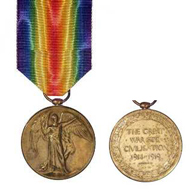
-
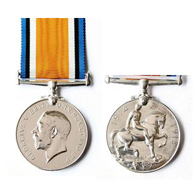
- Killed in action
- 8 November 1916
- France
- 29
- AIF Burial Ground - Flers - France
-
Witta and District Roll of Honor, Maleny R.S.L. Memorial Hall, Bunya Street, Maleny.
Soldiers Memorial Hospital Maleny Roll of Honor, Soldiers Memorial Hospital, Bean Street, Maleny.
Shire of Landsborough Roll of Honour, Caloundra RSL, West Terrace, Caloundra.
Australian War Memorial, Canberra Panel 177.
AIF Burial Ground, Grass Lane Flers.
-
National Archives. New South Wales Government Gazette, 18 October 1889. Dubbo Liberal and Macquarie Advocate on Wednesda,y 14 March 1894, page 2. Queensland Electoral Roll 1913. Benalla Standard, 28 April 1916.
- Helene

